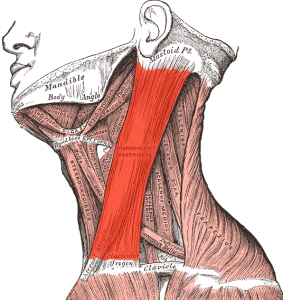If you’re a mother and you suddenly noticed how your baby has a preference to one side when tilting his head, looking, or would prefer to breastfeed on one side only because of his head, then there is a high possibility that your baby has torticollis.

What is Torticollis? It happens when tight muscles by the neck cause the baby to prefer one side and tilt his head in that direction. If the term torticollis isn’t familiar to you, then maybe the “wryneck” would ring a bell.
This is common in infants and is treatable as well. If it is present since birth, then the baby may have Congenital Muscular Torticollis. Most of the time, this is what develops on infants.

However, it is also possible to contract this condition after birth. It is called Acquired Torticollis and is often more severe as compared to the former.
What Causes Infant Torticollis
The sternocleidomastoid or SCM is a muscle found at the side of the neck. It extends from the back of the ear up to the collarbone. With Torticollis in babies, this muscle isn’t equal in size on both sides. One side is shorter than the other. This could be due to the position of the baby in the womb as abnormal or cramped. The unusual position or breach can cause the muscle to tighten because of the pressure being exerted on the head of the baby.
Another possible cause is the kind of birth delivery. If forceps or vacuum was used to deliver the baby, then, this might have also caused the SCM to tighten.
Infant Torticollis Signs And Symptoms
Symptoms of torticollis in infants may not be noticed immediately, considering babies are often born with it. The chances of you seeing something pertaining or related to torticollis would likely happen when the baby can move their head and neck.
Here are some symptoms of the condition:
- The head of the baby is tilted to one side while the chin is directed at the opposite direction or shoulder. Most of the time, the right side of the baby’s neck is affected.
- The infant finds difficulty in turning his head to both sides or up and down.
- If you touch the neck of your baby, there might be a soft lump, but don’t be too worried about it because it will go away on its own.
- The baby is not turning his head when looking at people and not following them with his eyes. He will have to look over his shoulder.
- Your baby is showing preference on which breast to feed.
- The baby shows the difficulty in turning his head and eventually becomes upset because of it.
- He might contract positional plagiocephaly wherein the head becomes flat on one side due to continually lay down on that part only.
When Should I Call My Doctor?

Usually, torticollis isn’t a fatal condition, but if it worries you, then set an appointment with a pediatrician for testing. There will be multiple tests done, like how many times the baby will turn his head for and X-rays and ultrasounds as well. Testing for this condition is necessary because there have been studies with evidenced reports that one in five babies with torticollis may also develop hip problems.
Other than that, torticollis doesn’t trigger any other disease or condition. However, some studies showed that sometimes it is linked to mild infections, bone problems, allergies, and other genetic conditions like Down syndrome.
Why Treatment Matters
Prevention is better than a cure. Therefore, acting before the condition worsens will always be the best decision. If not treated early on, then, the baby might also suffer from the following:

- More difficulty in controlling and moving the head
- Decreased movement on the affected side and the baby is less likely to follow people with his eyes
- Longer time to learn how to sit and walk
- Difficulty in eating or breastfeeding
- Less balance
- Imbalanced or uneven crawling
- Preference to one side when rolling
What You Can Do At Home
One of the best but cheapest ways to treat torticollis is to do neck stretching exercises on the baby.
Before doing it, though, ask your doctor for a professional opinion. These exercises are guaranteed to be safe and to balance the unequal length of the SCM by both elongating and strengthening the shorter muscle.
If you want to speed up the treatment, here are ways on how to do it:

Use how the baby eats as a motivation. If your baby prefers one side or one breast when feeding, turn him to the other one.
Use toys to grab the baby’s attention. Your baby might get attracted to toys that light up and has sounds, so use them to get him to look at both directions.
Playing with the hands and feet. Infants like doing this, especially when crawling, so use this to your advantage. It can strengthen his muscles.
Have some tummy time. Put your baby on your tummy for about 15 minutes, four times a day. It will help keep the head from being flat and also create stronger neck muscles. Not only that, but this can also be an excellent way to bond and play with your baby!
You can also read more tips here at Health Cleveland Clinic.
Other Treatments
Aside from the ideas mentioned above, the doctor may also suggest other treatments. Another possibility is for the doctor to recommend a physical therapist for home treatments.

The condition of your baby will progress within six months if the treatments and exercises given by the doctor are correctly done. To avoid complications and to accelerate the healing of the SCM, consult the doctor right away for proper diagnosis and treatment.
Though it does not happen often, there are times when surgery is needed to extend the SCM muscle and treat torticollis. However, don’t worry because this is a rare case. If it happens, then the operation can only take place if the child is a bit older.
FAQs
Does infant torticollis go away?
Yes, infant torticollis goes away. With exercise, you may need to wait for six to 12 months.
Can torticollis be treated?
Yes, infant torticollis can be treated. The treatment is typically a mix of physical therapy and oral medication.
Does torticollis cause development delays?
Yes, infant torticollis can cause developmental delays. To be specific, it can affect their balance and cognitive skills.
Does my baby have left or right torticollis?
You can tell if your baby has left or right torticollis based on which side of the neck is tight. If it is left, then they have left torticollis. If it is the right, they are dealing with right torticollis.
Does torticollis hurt my baby?
No, torticollis does not hurt your baby. However, it can be painful for parents to see their beloved child unable to move their neck.
How common is infant torticollis?
Infant torticollis is found in three out of 100 babies. Still, it is easy to treat, so there is nothing to worry about.
Is torticollis a neurological condition?
Yes, spasmodic torticollis is a neurological condition. It affects the neck muscles and prevents the patient from moving their neck in all directions.
Is torticollis a disability?
Not all forms of torticollis can be considered as a disability. You may obtain Social Security for disabilities, though, if you have been diagnosed with spasmodic torticollis.
How should a baby with torticollis sleep?
A baby with torticollis should sleep in the same direction as the weak side of their neck. It will keep their muscles from getting forced more than they should.
How do you hold a baby with torticollis?
You can hold a baby with torticollis by keeping them upright. Turning their head in the opposite direction is sometimes recommended as part of stretching exercises.
How is torticollis diagnosed?
Doctors typically conduct neurological and physical examinations to diagnose torticollis. They may also check if the SCM muscle in the neck is palpitating because it is common in one out of three patients.
Can a chiropractor help with baby torticollis?
Yes, a chiropractor can help with baby torticollis. It is among the alternative treatments that an infant can safely try.
How is torticollis prevented?
Torticollis can be prevented by making sure that the infant’s head does not stay in a single direction 24/7. You may turn their head by yourself if they don’t want to move it.
Other Resources:
https://www.seattlechildrens.org/globalassets/documents/for-patients-and-families/pfe/pe347.pdf
https://www.pampers.com/en-us/newborn-baby/development/article/torticollis-in-babies
Last Updated on January 11, 2023 by Rejie Salazar
DISCLAIMER (IMPORTANT): This information (including all text, images, audio, or other formats on FamilyHype.com) is not intended to be a substitute for informed professional advice, diagnosis, endorsement or treatment. You should not take any action or avoid taking action without consulting a qualified professional. Always seek the advice of your physician or other qualified health provider with any questions about medical conditions. Do not disregard professional medical advice or delay seeking advice or treatment because of something you have read here a FamilyHype.com.